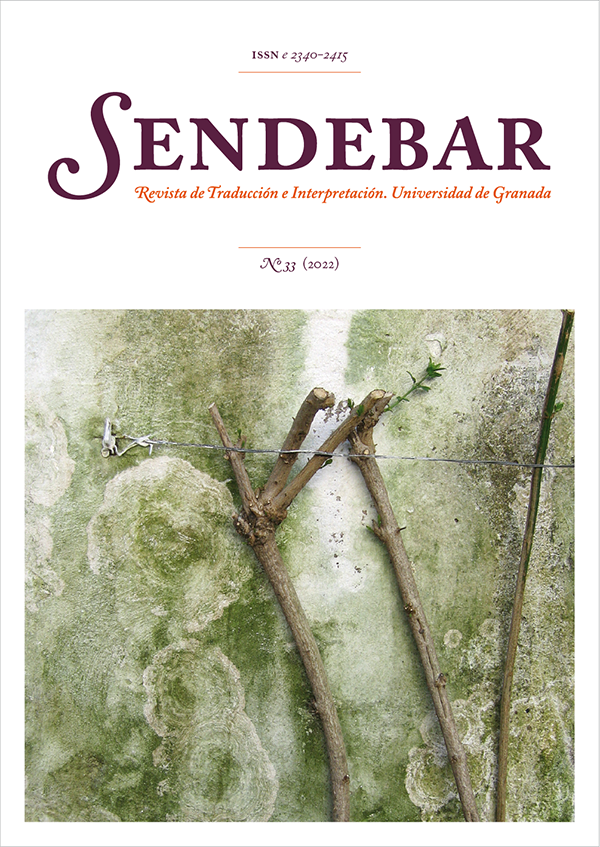Hybridisation of Genres and Translation: La alumna by Alessia Gazzola
DOI:
https://doi.org/10.30827/sendebar.v33.18503Keywords:
Literary translation, hybridisation of genres, detective novel, chick lit, Alessia GazzolaAbstract
This article aims to analyse the translation into Spanish of the novel by Alessia Gazzola L'allieva (La alumna, translation by Patricia Orts). The main characteristic of this work is the hybridisation of genres, specifically the detective-police novel and the chick lit. Starting from the idea that each literary genre generates a series of expectations in the reading public, and that the translator must master the resources and mechanisms that allow a genre to be identified as such, the following pages will show the points of union and divergence between the chick lit and the detective-police novel in L’allieva, and how the translation of its particularities has been approached, giving priority to the elements that are typical of the latter.
Downloads
References
Alessandro, A. & S. Molpereces Arnáiz (2015). Nuevas vías para la novela negra: Mezcla de géneros, intertextualidad y traducción en Acqua in bocca de Camilleri y Lucarelli. En J. Sánchez Zapatero y Á. Martín Escribá (Eds.), El género eterno. Estudios sobre novela y cine negro (pp. 201-210). Andavira.
Ascari, M. (Coord.). (2020). Monográfico dedicado a Genre B(l)ending. Crime’s Hybrid Forms. Clues. A Journal of Detection, 37 (3).
Bazzanella, C. (2020). Insulti e pragmatica: complessità, contesto, intensità. Quaderns d’Italià, 25, 11-26. https://doi.org/10.5565/rev/qdi.479
Berisso, M. (2000). Livelli linguistici e soluzioni stilistiche. Sondaggi sulla nuova narrativa italiana 1991-1998. Lingua e stile, XXXV (3), 471-504.
Briganti, A. (2014). Parole in libertà. Alessia Gazzola la signora in giallo del medical thriller. La Repubblica, 2 de febrero. https://ricerca.repubblica.it/repubblica/archivio/repubblica/2014/02/02/parole-in-liberta-alessia-gazzola-la-signora.html
Brumme, J. (2012). Traducir la voz ficticia. De Gruyter.
Brumme, J. & A. Espunya (Eds). (2012). The translation of Fictive Dialogue. Rodopi.
Brumme, J. & H. Resinger (Eds.). (2008). La oralidad fingida, obras literarias: descripción y traducción. Iberoamericana.
Cadera, S. M. & A. Pavić Pintarić (Eds.). (2014). The voices of suspense and their translation in thrillers. Rodopi.
Calvo Rigual, C. & N. Spinolo (Eds.). (2016). MONTI. Monografías de Traducción e Interpretación: Translating orality / La traducción de la oralidad. https://doi.org/10.6035/MonTI.2016.
Chaume, F. (2004). Cine y traducción. Cátedra.
Culpeper, J. (2011). Impoliteness. Using Language to Cause Offense. Cambridge University Press.
Cunillera, M. & H. Resinger (Eds). (2011). Implicación emocional y oralidad en la traducción literaria. Frank & Timme.
Díaz Alarcón, S. (2013). Literatura, Novela Policíaca y Lenguaje Científico, Skopos, 2, 29-50.
Eco, U. (en línea). Tu, Lei, la memoria e l’insulto. Disponible en <http://www.festivalcomunicazione.it/wp-content/uploads/2015/09/UMBERTO-ECO_Lectio-Magistralis-2015.pdf>Ferriss, S. (2015). Working Girls. The Precariat of Chick Lit. En E. Levine (Ed.), Cupcakes, Pinterest, and Ladyporn: Feminized Popular Culture in the Early Twenty-First Century (pp. 177-195). University of Illinois Press.
Ferriss, S. & M. Young (Eds.). (2006). Chick Lit: The New Woman’s Fiction. Routledge.
Gazzola, A. (2011). La mauvaise élève. (A. Bokobza Trad.). Press de la Cité (Original publicado en 2011)
Gazzola, A. (2012). La alumna. (P. Orts Trad.). Suma (Original publicado en 2011)
Gazzola, A. (2016) [2011]. L’allieva. Longanesi.
Giavara, A. (2018). Un bisturi in mano a Bridget Jones. L’Allieva di Alessia Gazzola, un innesto rosa-giallo. En AA.VV., Editoriale, Watson! Libri gialli sotto indagine (pp. 69-75). Edizioni Santa Caterina. Quaderni del master di editoria 11.
Giovanetti, S. (2009). Chick-lit: una letteratura rosa shopping. En L. Del Grosso Destreri, A. Brodesco, S. Giovanetti y S. Zanatta (Eds.), Una galassia rossa. Ricerche sulla letteratura femminile di consumo (pp. 85-136). FrancoAngeli
Harzewski, S. (2011). Chick Lit and Postfemism. University of Virginia Press.
Horsley, K. & L. Horsley (2006). Body Language: Reading the Corpse in Forensic Crime Fiction. Paradoxa: Terrain Vagues, 20, 7-32
Lluch, G. (1998). El lector model en la narrativa per a infants i joves. Universitat Autònoma de Barcelona, Universitat Jaume I, Universitat de València
Manchette, J.-P. (2003[1996]). Notes noires: Traduc-tueur? (Polar nº 11). Chroniques (pp. 361-369). Rivages.
Mazza, C. (2006). Who’s laughing now? A short history of chick-lit and the perversion of a genre. En S. Ferriss y M. Young (Eds.), Chick-Lit: The New Woman’s Fiction (pp 17-28). Routledge.
Montoro, R. (2012). Chick Lit: The Stylistics of Cappuccino Fiction. Bloomsbury.
Narbona Jiménez, A. (2001). Diálogo literario y escritura(lidad)-oralidad. En R. Eberenz (Ed.), Diálogo y oralidad en la narrativa hispánica moderna. Perspectivas literarias y lingüísticas (pp. 189-208). Verbum.
Nencioni, G. (1983). Parlato-parlato, parlato-scritto, parlato-recitato. En Di scritto e di parlato. Discorsi linguistici (pp. 126-179). Zanichelli
Novelli, M. (2020). Donne in cerca di guai. En Tirature 2019 (pp. 39-42). Mondadori.
Ondelli, S. (2020a). L’italiano delle traduzioni. Carocci.
Ondelli, S. (2020b). Moda, forestierismi e traduzioni: un confronto interlinguistico. Lingua cultura mediazioni, 7, 71-90. https://doi.org/10.7358/lcm-2020-002-onde
Orsini, I. M. (2014). Donne in giallo. La detective story fra genere e gender. Mimesis.
Re, V. (2019). Quo vadis, baby? Le donne e il crime drama. Fata Morgana Web, Seriale-Reale, 8 (octubre), 20-24. https://www.fatamorganaweb.it/quo-vadis-baby/
Real Academia de Medicina (en línea). Diccionario de términos médicos. https://dtme.ranm.es/index.aspx
Ricci, L. (2013). Paraletteratura. Lingua e stile dei generi di consumo. Carocci.
Ryan, M. (2010). Trivial or Commendable?: Women’s Writing, Popular Culture, and Chick Lit. 452ºF. Electronic journal of theory of literature and comparative literature, 3, 70-84. https://core.ac.uk/download/pdf/13296686.pdf
Sabatini, F. (1985). L’ ‘italiano di uso medio’. Una realtà tra le varietà linguistiche italiane. En G. Holtus & E. Radtke (Eds.), Gesprochenes Italienisch in Geschichte und Gegenwart (pp. 154-184). Narr.
San Vicente, F. & E. Morillas (Coords.). (2014). Cuadernos Aispi. Monográfico dedicado a “Oralidad contrastiva español-italiano: aspectos gramaticales, discursivos y textuales”. http://www.ledijournals.com/ojs/index.php/cuadernos/issue/view/77
Smith, C. J. (2007). Cosmopolitan Culture and Consumerism in Chick Lit. Routledge.
Tartamella, V. (2006). Parolacce. Perché le diciamo, che cosa significano, quali effetti hanno. BUR.
Vidal Claramonte, M. C. Á. (2012). El lenguaje de las revistas femeninas españolas: la (no) traducción como ideología. Meta, 57(4), 1029–1045. https://doi.org/10.7202/1021231ar
Downloads
Published
How to Cite
Issue
Section
License
Terminos de Licencia Sendebar.

















